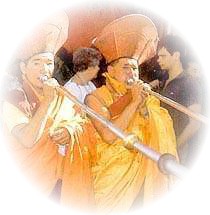| LOSSAR
FESTIVAL |
|
| Location :
Ladakh, JK |
|
| Feature :
New Year Festival |
|
| Begun in :
17th Century |
|
| In the month
of :
December |
|
|
|
How Ladakh got its New Year
11 Dec. 1996, 30 Dec, 1997
19 Dec. 1998, 8 Dec, 1999
This New Year festival has an interesting history. In the 17th century, King
Jamyang Namgyal decided to lead an expedition against the Balti forces during
winter. He was advised that any expedition before the New Year celebrations by
two months, establishing a tradition that people still follow - celebrating
Losar on the first day of the eleventh month of every year. |
|
Blending Buddhism with
Bonism
Losar is the most elaborate of all the socio-religious events of Ladakh. It
involves the entire population of the region. Interestingly, the rites and
rituals are a mixtures of Buddhist and the pre-Buddhist Bon religious
practices. Preparations start by the end of the harvest period when people
start stocking provisions, sheep and goats for the customary feasts as well as
grain for brewing 'chang' (a local barley beer). New clothes and jewellery are
kept ready for the occasion. |
 |
|
|
Lights and Feasting
The festivities start on the 29th day of the 10th month with the illumination
of buildings and shrine. Sheep and goats reserved for the occasion are ritually
slaughtered to begin the series of evening feasts for all relatives by
rotation. |
|
Ritual and warmth
The New Year day itself starts with the offering of votives and greetings to
various gods, elders, relatives and friends. Afterwards, the elders await the
customary visitors who come to greet the family with presents and 'Khatak'
(ceremonial scarf).
|
|
| The younger members go out to visit other
families. Leh and its adjoining villages wear a carnival look as people come
out in their colourful best. It is customary for the Muslims and Christians in
Leh to visit their Buddhist friends and greet them on the eve of Losar. |
|
Guardians of prosperity
Images of ibex and other auspicious symbols are put on the door, walls of the
kitchen and the top-end of its central wooden column. The ibex is a symbol of
fertility and is believed to bring prosperity. Small images of the ibex moulded
from dough are arranged on kitchen shelves to add to the good luck. |
|
The procession of fire
In the evening, the 'Metho' ceremony takes place. The bazaars of Leh and the
streets of villages get lit up as processions bearing flaming torches pass
through with the people chanting slogans to chase out evil spirits and hungry
ghosts - the result of bad Karma (one's deeds). Whirling torches create a
fantastic display of fire and light. At the end of it all, the torches are
thrown well outside the town to bid farewell to the old year and to welcome the
new one. |
|
|
|
|
|